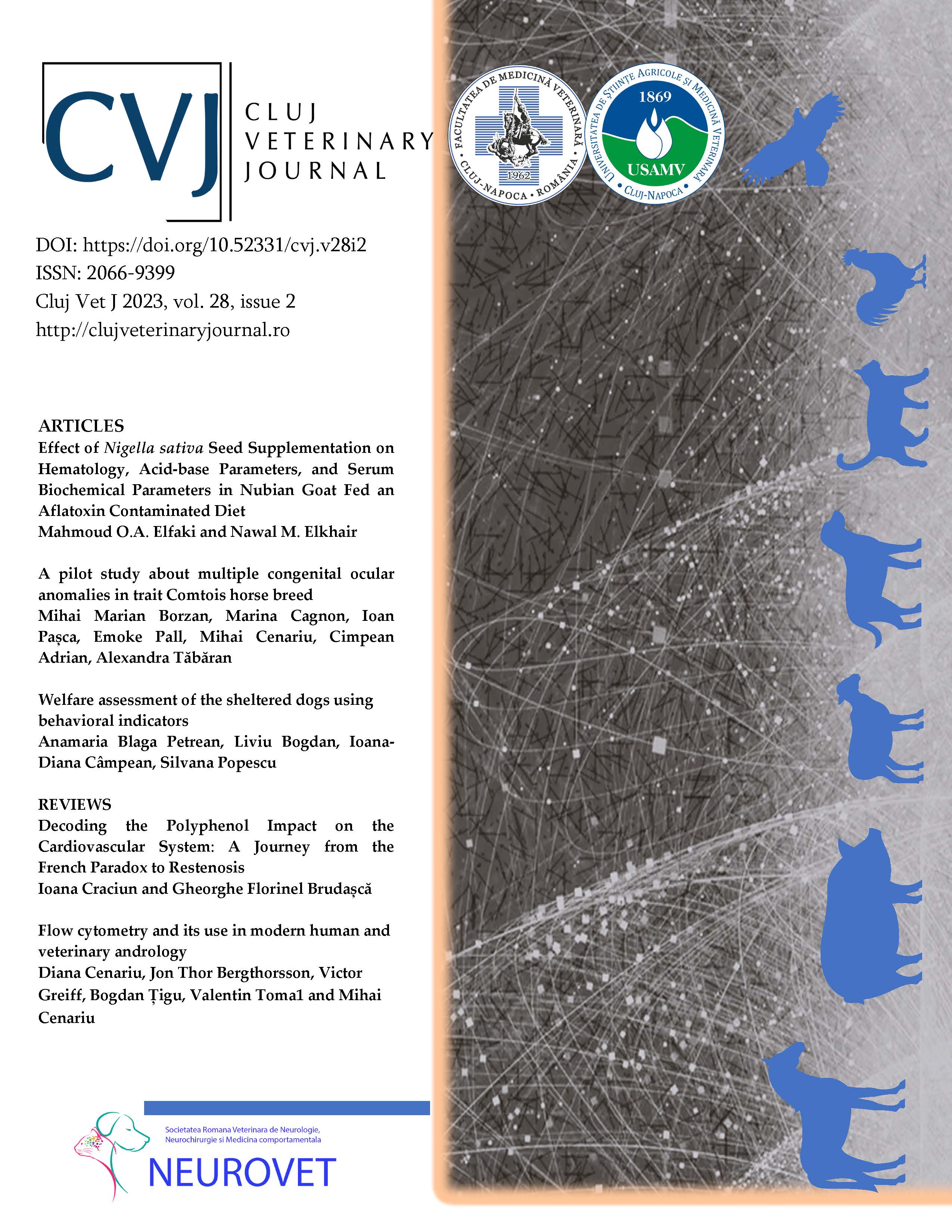Flow cytometry and its use in modern human and veterinary andrology
DOI:
https://doi.org/10.52331/cvj.v28i2.49Keywords:
flow cytometry, semen analysis, viability, acrosome reaction, mitochondrial activityAbstract
Fertility of a male is sometimes difficult to assess and results obtained using regular sperm analysis methods are often inconclusive. Flow cytometry was proven to generate crucial information, that allows specialists to conclude upon the reproductive capacity of an individual. Together with computer assisted sperm analysis CASA systems, flow cytometers allow an in-depth analysis of fresh, chilled or frozen/thawed semen, which is currently essential for research purposes, but also for diagnosis of various male-related fertility disorders, both in veterinary and human medicine. Several parameters can be assessed using this method, such as sperm viability, acrosome integrity, mitochondrial activity, concentration and total sperm number, DNA fragmentation, capacitation, oxidative stress, etc. This paper provides a rapid reference to specialists involved in semen analysis by flow cytometry, regarding semen sample preparation, instrument setup, and evaluation of the most important sperm parameters (viability, acrosome reaction and mitochondrial activity).
References
Petrunkina, A.M.; Harrison, R.A. Cytometric solutions in veterinary andrology: developments, advantages, and limita-tions. Cytometry A 2011, 79, 338–348.
Peña, A.I.; Johannisson, A.; Linde-Forsberg, C. Validation of flow cytometry for assessment of viability and acrosomal integrity of dog spermatozoa and for evaluation of different methods of cryopreservation. J Reprod Fertil 2001, Suppl 57, 371-376.
Januskauskas, A.; Johannisson, A.; Rodríguez Martínez, H. Subtle membrane changes in cryopreserved bull semen in relation with sperm viability, chromatin structure and field fertility. Theriogenology 2003, 60, 743-758.
Spinaci, M.; De Ambrogi, M.; Volpe, S.; Galeati, G.; Tamanini, C.; Seren, E. Effect of staining and sorting on boar sperm membrane integrity, mitochondrial activity and in vitro blastocyst development. Theriogenology 2005, 64, 191-201.
Nagy, S.; Jansen, J.; Topper, E.K.; Gadella, B.M. A triple stain flow cytometric method to assess plasma and acrosome membrane integrity of cryopreserved bovine sperm immediately after thawing in presence of egg-yolk particles. Biol Reprod 2003, 68, 1828-1835.
Garner, D.L.; Johnson, L.A. Viability assessment of mammalian sperm using SYBR-14 and propidium iodine. Biol Reprod 1995, 53, 276-284.
Peña, F.J.; Saravia, F.; Johannisson, A.; Walgren, M.; Rodríguez-Martínez, H. A new and simple method to evaluate early membrane changes in frozen-thawed boar spermatozoa. Int J Androl 2005, 28(2), 107-14.
Idziorek, T.; Estaquier, J.; De Bels, F.; Ameisen, J.C. YOPRO-1 permits cytofluorometric analysis of programmed cell death (apoptosis) without interfering with cell viability. J Immunol Methods 1995, 185, 249-258.
Anzar, M.; He, L.; Buhr, M.M.; Kroetsch, T.G.; Pauls, K.P. Sperm apoptosis in fresh and cryopreserved bull semen detected by flow cytometry and its relationship with fertility. Biol Reprod 2002, 66, 354-360.
Kurz, A.; Viertel, D.; Herrmann, A.; Müller, K. Localization of phosphatidylserine in boar sperm cell membranes during capacitation and acrosome reaction. Reproduction 2005, 130, 615-626.
Martínez-Pastor, F.; Mata-Campuzano, M.; Álvarez-Rodríguez, M.; Álvarez, M.; Anel, L.; De Paz, P. Probes and Tech-niques for Sperm Evaluation by Flow Cytometry. Reprod Dom Anim 2010, 45, 67-78.
Downloads
Published
Issue
Section
Categories
License
Copyright (c) 2023 Diana Cenariu, Bergthorsson Jon Thor, Greiff Victor, Toma Valentin, Cenariu Mihai

This work is licensed under a Creative Commons Attribution 4.0 International License.





